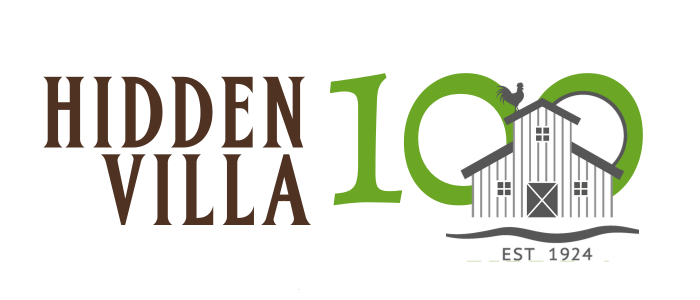Vision
Our vision is a sustainable, healthy, and just future for all.
Mission
Our mission is to foster educational experiences that build connections and inspire a deeper appreciation and respect for nature, food, and one another.
Values
Our values are: Access, Community, Exploration, and Stewardship.
This legacy began in 1924, when Frank and Josephine Duveneck purchased the property near Los Altos in 1924 and began sharing the land and creating humanitarian programs that have inspired many generations. The Duvenecks were profoundly generous and dedicated to creating a just and sustainable future for all.
Today, the Hidden Villa Board of Trustees remains committed to the lessons long taught by the Duvenecks and sustained by our organization since their passing. We stand opposed to discrimination based on ethnicity, national origin, religion or sexual identity. We support environmental regulations that preserve our healthy environment and food systems through regenerative agriculture, and most of all, we strive to inspire future leaders and stewards of the earth.
Learn about our Educational Philosophy and our practice of Responsible Agriculture.
Hidden Villa Timeline
Hidden Villa was established.
Opened the first hostel on the Pacific coast.
Provided housing and re-settlement support for Japanese Americans returning from internment camps.
Created the first multi-racial, residential summer camp.
Established the Trust for Hidden Villa as a nonprofit.
Supported Cesar Chavez and Dolores Huerta in organizing the National Farm Workers Movement (which became the UFW)
Developed the Hidden Villa Environmental Education Program.
Community Programs begins.
Community first has access to Hidden Villa produce; the Community Supported Agricultural (CSA) share box program begins.
Community Services Agency of Mountain View partnership begins and continues today providing over 40,000 servings of fresh produce annually.
Middle and High school aged programming expands to include the school year.
Summer Camp program expands to include Kinder Camp and a Citizen Scientist backing packing trip in the Sierras
Expanded weekend offerings.
Hidden Villa launches a Food Worth Celebrating series – a program for people of all ages to connect with their food.
Check back as we update our timeline as we enter the next chapter of our mission.
History Archival
Blog By Eric F., Hidden Villa Historian & Archivist
History of Hidden Villa
October 2023
Harvest Festival Late 1970’s
Over the last month or so, another volunteer and I have been spending some time over at the Los Altos History Museum, helping them work through their collection of photographs about the Duvenecks and Hidden Villa. While there are many interesting images from as early as the 1930’s (or before), the one I’ve chosen for this month is a nice one of Frank and Josephine doing what they loved best, helping the community. Based on the badge on Josephine’s blouse (i.e. FCL Harvest Festival), we are sure this is one of the early Quaker Harvest Festivals that used to be hosted at Hidden Villa. As anybody who has read Josephine’s Autobiography (Life on Two Levels) knows that there is a strong connection between Josephine, Hidden Villa, and the Quakers. In fact, the first 27 Quaker Harvest Festivals were held at Hidden Villa (1966-1993) and the 57th was recently held in Palo Alto. The Duvenecks had a great knack for starting and supporting enduring traditions.
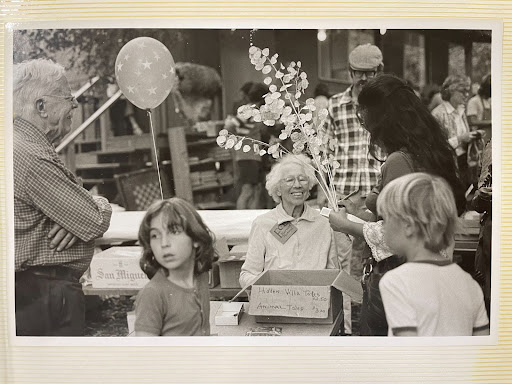
We are not (yet) sure exactly where or when this photo was taken, but we can get pretty close. The photo must be from between 1975 and 1978, as we know that Hidden Villa Tales was published in 1973 and Hidden Villa Animal Tales in 1975 (both are listed for sale at $2.50 and $3 respectively on the box in front of Josephine!) and Josephine passed away in 1978. As for where on Hidden Villa, we are also not (yet) 100% sure, but we think the photo might be taken somewhere around the location of the 2nd Hostel based on the building and greenery around it. If anybody has a better idea or would like to join us in better preserving, expanding, and sharing Hidden Villa’s history for its next 100 years, we would love to hear from you at [email protected].
(Image courtesy of the Los Altos History Museum (from the Liz Dana Collection, Box 15)
September 2023
Finding the First Duveneck Deed
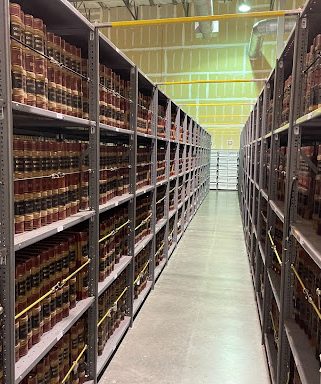 Hi, welcome to the inaugural post of a (hopefully) long running series about interesting periods and new facts about Hidden Villa’s history. In honor of the kick off of the anniversary of 100 years of Duvenecks at Hidden Villa, I thought it would be fitting to share a little bit about the quest to confirm exactly when the Duvenecks bought the first parts of Hidden Villa.
Hi, welcome to the inaugural post of a (hopefully) long running series about interesting periods and new facts about Hidden Villa’s history. In honor of the kick off of the anniversary of 100 years of Duvenecks at Hidden Villa, I thought it would be fitting to share a little bit about the quest to confirm exactly when the Duvenecks bought the first parts of Hidden Villa.
It is more complicated than at first it might appear as the available written sources differ. Josephine Duveneck writes in her 1978 autobiography “Life on Two Levels” that it was in 1924, yet two other historians (Phyllis Filiberti Butler in 1975 and Florence Fava in 1976) both reported 1923. There is even a sign near the gates of Hidden Villa that says 1925. Who is right, who is mistaken? Who knows! What is an aspiring historian to do? Enter the Source Document.
Errors creep into the historical records, much like the children’s game of telephone. Historians (of which I only consider myself at best a Historian in Training) are constantly in search of primary sources. I am coming to believe that a large part of being a Historian is knowing where to find the relevant primary sources. When in doubt check the sources. Even when not in doubt, you should probably check the sources.
After much head-scratching, I realized that in this case, the Santa Clara County Archives (with which I was already familiar due to previous research into historic aerial photographs, more on that another day) held the collections of the County of Santa Clara Official Records. It can be a bit overwhelming though. They have a lot of records. I mean a lot of records.
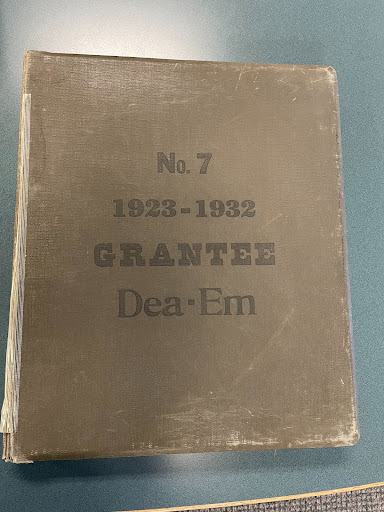 This many books makes sense though when you think about it, as every single property transaction since 1850 in the entire Santa Clara County is recorded, plus a lot of other things like mortgages, change of names, etc.. One could hope that it was already digitized. While it has been microfiched and those digitized, the early records, handwritten in cursive, is not necessarily readily machine searchable and there are also various legal reasons why you can only access the digital records from the County Clerk Recorders office.
This many books makes sense though when you think about it, as every single property transaction since 1850 in the entire Santa Clara County is recorded, plus a lot of other things like mortgages, change of names, etc.. One could hope that it was already digitized. While it has been microfiched and those digitized, the early records, handwritten in cursive, is not necessarily readily machine searchable and there are also various legal reasons why you can only access the digital records from the County Clerk Recorders office.
That said, luckily for us, somebody in the Clerk Records Office back in the day was assigned the job of building an Index for all these records. This was long before the time of computers, so the index had to be done by hand. Enter the Grantor/Grantee Indexes.
Basically, if you 1) know an approximate year, and 2) know the last name you are looking for, and 3) have a lot of patience, you might be in luck. I’m saving you a bunch of time from getting used to reading cursive and jumping right to the relevant page. See if you can find the relevant entry. It is there, I promise.
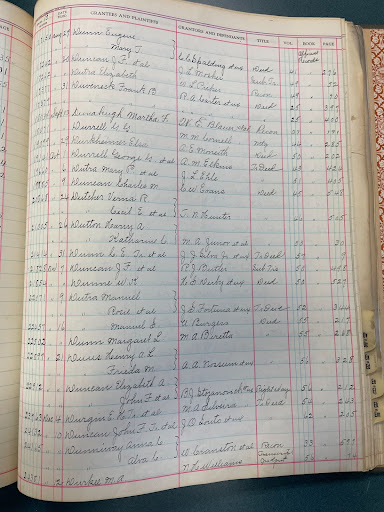 .
.
Page of 1923-1932 Grantee Index where the Duvenecks make their entrance into the historical record (with regards to Hidden Villa at least)
On the 5th row, a transaction is recorded as follows: On August 31 (I know it is 1923 from the unshown left side page), Duveneck, Frank B. (grantee) received from Carter, R.A et ux (grantor) a Deed as recorded starting on page 397 of Book 25 of the Official Record of Santa Clara County.
So you might be thinking that’s it, case closed. 1923 it is! But not quite yet… One has to check the actual deed to make sure the transaction is the one you hope it is. Since I had found many other additional transactions of possible interest (including for example one from 1918 that turned out to be Josephine’s purchase of their house in Palo Alto while Frank was away for WWI), the initial pull request was significant.
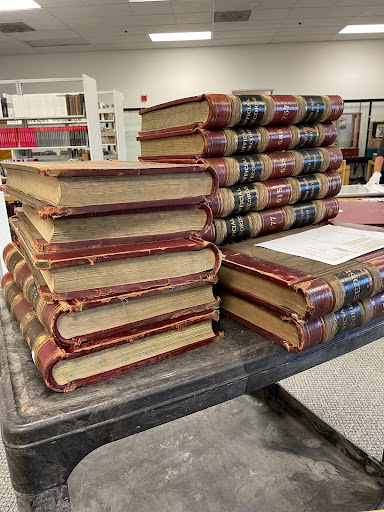 Stack of Official Records to review for actual recorded deeds of potential interest
Stack of Official Records to review for actual recorded deeds of potential interest
When I finally got to Official Record Book 25 it was pretty clear that the 8/31/1923 transaction was the correct one. Starting on page 397 of Book 25 of the Official Records of Santa Clara County, a simple 2 page deed is transcribed (pictures follow). While there is a fair amount of legalistic broiler plate, it is dated August 23rd, 1923, notarized on the same day, and officially recorded on August 31, 1923, and records the fact that Royle A. Carter and Jean Lind Carter (his wife) deeded 869.42 acres to Frank B. Duveneck.
History Archives
Update from History @ Hidden Villa
Been a while since I’ve provided an update. There’s been a lot of progress & interesting finds but we’ve also been scrambling to get a new trial experiential learning collaboration with Foothill College History Department up and running so that is what I’ll write about today.
I’m excited (and relieved) to say that the first 10 days are successfully behind us. Already we’ve had 100+ hours from 27 Foothill student “volunteers”. I say “volunteer” in quotes as many, but not all, have to do 10 hours of “volunteering” at a local history archive for a History class project. Rather than making them come to the archive, we’ve been allowed to bring the archive to them : ). Foothill has provided a dedicated room and the students and supportive oversight, and HV has provided the materials, procedures, and additional oversight. Current student projects are indexing (at the folder level) content of about 20 banker boxes so we’ll know what is in them, and also helping organize, rehouse and then index massive amounts of loose photos, slides, contact sheets, and negatives. A quick, probably low, estimate is 10,000+ images. Most of the images seem to be from the 80’s and 90’s but I’ve also seen at least a few early ones from the 1940’s that are new to me at least. Projects in upcoming quarters will likely be digitizing higher priority images and attaching meta data, building catalogs of newspaper clippings, etc. Long range, I’m hoping some students will grow with the archive and decide to do independent study projects like building finders aids or a research project on an area of particular interest to them.
Working with a new group of Foothill students is fun. Maybe 1/3rd of them remember visiting HV at least once, some many times, during their childhood so it is nice to help them reconnect even if just a little bit. The other ⅔ are slowly learning about it via osmosis while helping sort photos and I hope to arrange for a short history tour/visit for them someday soon.
Big thanks to History @ Hidden Villa volunteers (Leilani Marshall, Margie Alving, and also Willow Lachter our Foothill student procedure tester extraordinaire), everyone at HV (especially Marlene, Sofia, Heather, Elliott, . . . ) and Foothill (Prof. Ziegenhorn of the History Department, and Prof. Connell of the Anthropology Dept as well as Alex Collins, Dr. Aaron Korngeibel, Dean of the Business and Social Science Division and his boss, Dr. Stacy Gleixner, VP of Instruction all of whom were instrumental in getting approval for the plans) who have helped make this collaboration a success!
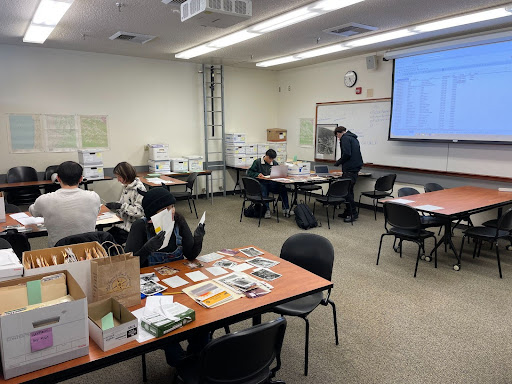 Foothill College Students helping organize Hidden Villa’s archives @ Foothill College as part of an ongoing American History Class assignment.
Foothill College Students helping organize Hidden Villa’s archives @ Foothill College as part of an ongoing American History Class assignment.
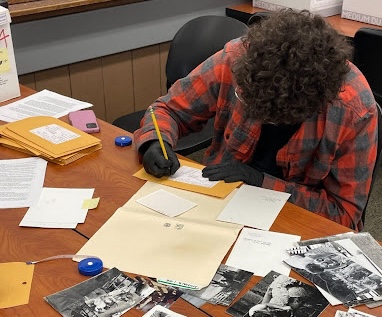
Example sorting and preparing for image cataloging/inventory
